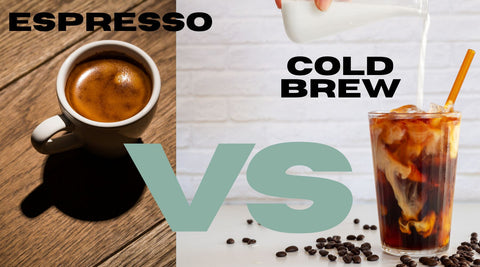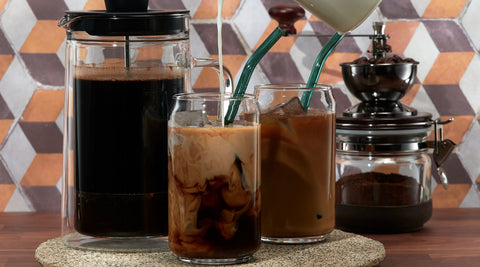All coffee lovers with a basic understanding of coffee know that coffee comes in many forms: When it comes to coffee with a good kick, you can choose between strong espresso shots, typically served in dainty cups, and a cold brew, usually served in a glass.
But what’s the difference apart from serving size and temperature? What's better to make an iced coffee? Which is better for a good caffeine boost? Before we get to all the details, let's look at:
Cold Brew vs Espresso - The Quick Answer:
QUICK ANSWER.......🢃˗ˏˋ☕ˎˊ˗
If you're looking for a quick caffeine fix, espresso drinks win. It's prepared much quicker than a cold brew and offers a concentrated burst of energy. However, cold brew might be your go-to if you prefer a smoother, less acidic option.
Want to know more? Let's take a brief look at the main differences and then take a closer look at the details. After reading this article, your answers about the war espresso vs cold brew should all be answered.

What Is Cold Brew?
Cold brew coffee has become popular recently and is especially well-loved during the warmer months. It's a brewing method that takes patience.
Cold brew coffee isn't complicated, but it takes some time. Its simplicity and distinct flavor profile are why it's so popular. So, how does it work?
Easy: Instead of using hot water, this brewing process involves steeping ground coffee in cold water for a fairly long period. Steeping the coffee grounds in cold water takes around 12 to 24 hours. The result is a smooth, less acidic coffee concentrate often diluted with even more cold water or milk before serving. While many coffee drinkers drink cold brew as it is, it also works well as an iced coffee.
Of course, you can also add syrups and sugar, depending on your preferences. Pouring a cold brew over some vanilla ice cream is also pretty nice if you're after a sweet treat.
What Is Espresso Coffee?
Espresso coffee has been around for well over a century and was invented by an Italian who wasn’t patient and wanted to find a way to get his coffee drinks faster. The brewing process for espresso is much faster than for traditionally brewed coffee. It’s the drink for people who want their coffee NOW.
Espresso coffee is a concentrated coffee shot. An espresso shot is brewed by forcing hot water through fine coffee grounds under high pressure (the espresso machine does that for you, so it's still simple but a little more complex than a cold brew). The process extracts flavors quickly. The result is a small but intense shot of coffee. Espresso coffee can be enjoyed as it is but also serves as the base for various popular coffee drinks like lattes, cappuccinos, and Americanos.
Is Espresso Stronger Than Cold Brew?
The strength of coffee can be subjective - both pack a kick. But when you look at the caffeine content, a cold brew is not as strong as espresso.
Some people make the mistake of only looking at the caffeine content per serving size and then thinking cold brew has more caffeine. But a serving of cold brew is larger than a shot of espresso.
With that in mind, let's look: One serving of cold brew coffee has around 200-250 mg of caffeine, while a serving of espresso has around 65-68 mg. One espresso shot is 1 oz. A serving of cold coffee can be anything from 8 to 16 oz. Even if it's only 8 oz, 1 oz of cold brew coffee contains around 28 mg of caffeine. Espresso is the clear winner here as it has more caffeine per oz.
Choosing Your Coffee Bean
Origin:
The origin of your ground coffee beans influences the flavor of both cold brewed coffee and espresso. Cold brew coffee often highlights the nuanced flavors of the coffee beans, making origin distinctions more apparent. Espresso tends to have a bolder, more intense flavor, potentially overshadowing some subtleties, so you need to choose your beans accordingly.
Colombian, Nicaraguan, and Honduran tend to work well for cold brews, but ultimately, it's up to what type of coffee flavor you prefer.
Roast Level:
Cold brews can showcase the unique characteristics of light roasts, while espresso is traditionally associated with a medium roast or dark roast. However, blonde espressos (light roast espressos) have become popular in recent years thanks to Starbucks coffee shops.
Cold Brew vs Espresso: The Major Differences
Taste & Flavour
Cold brew tastes smoother, less acidic profile with subtle undertones. This makes it ideal for people who find traditional coffee too bitter. Espresso is bold and intense and often carries a pronounced bitterness. Of course, the taste of each brewing method depends much on the beans' origin, processing method, and roast level.
How Much Caffeine Content?
As explained above, espresso is the winner if you're looking for a quick caffeine kick. The concentrated brewing process extracts more caffeine per ounce than the slow cold extraction. Out of the two brewing methods, a cold brew has less caffeine per oz than a regular cup of espresso drink.
Brewing Time
Patience and planning ahead are key when it comes to cold brew. The cold brewing process requires 12 to 24 hours, so you must make your coffee well before you want to drink it. In contrast, espresso is all about speed. The entire brewing time is only 25 to 30 seconds.
Acidity
Cold brew coffee is loved for its low acidity, making it a gentle option for sensitive stomachs. Espresso, with its quick extraction process, tends to be a more acidic cup.
Which Grind Size For Ground Coffee?
Choosing the correct grind size for your ground beans is important for brewing coffee, no matter what type. Cold brew coffee requires a coarse grind to prevent over-extraction during the steeping period. Espresso, on the other hand, demands a fine grind.
Conclusion
In the coffee world, there is no clear winner in the battle of cold brew vs espresso because both cater to different preferences. The choice boils down to whether you crave a quick, intense caffeine hit (espresso) or a more relaxed, nuanced coffee experience (cold brew). As a coffee enthusiast, you should experiment with both methods and different coffee recipes and explore how different beans and roast levels influence the flavors - over time, you'll find the perfect cup for your coffee fix.
FAQ
Should You Use Cold Brew Or Espresso For Iced Coffee?
The choice between cold brew vs espresso for iced coffee depends on personal preference. Go for iced espresso if you enjoy strong, dark flavors with a quick kick. On the other hand, if you prefer a smoother, milder taste, iced cold brew coffee is the way to go.
How Much Cold Brew Equals A Shot Of Espresso?
While there's no direct conversion due to the different brewing processes, a common guideline is that one ounce of espresso is roughly equivalent to three ounces of cold brew when considering caffeine as your guideline when comparing cold brew vs espresso drinks.
How Does the Brewing Temperature Affect the Taste of Cold Brew and Espresso?
The brewing temperature significantly influences the flavor profiles of cold coffee and espresso. Cold brew coffee extract is usually milder and has a smoother taste profile with fewer acidic notes. Espresso, which is hot brewed coffee, is bold and intense, often with a pronounced bitterness.
Can I Use the Same Coffee Beans for Cold Brew and Espresso?
Yes, you can use the same coffee beans for cold brew and espresso, but the taste will be slightly different. Cold brew tends to bring out the nuanced flavors of the beans due to the slow extraction process. You'll notice the flavors of the beans' origin and the influence of the roast level more with this method. Espresso, on the other hand, brings out the bolder aspects of the beans.


